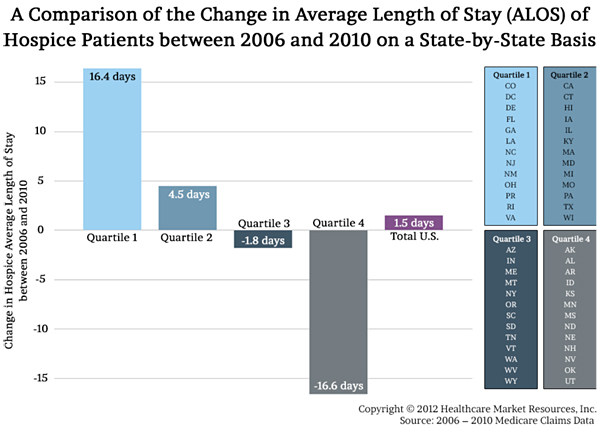Goal 6
OBJECTIVES
- Promote and support a systematic approach to monitor, disseminate and utilize data trends to advocate for high quality hospice care, including trends relevant to disparities
- Promote and support system changes that strengthen the quality of hospice care through partnerships with providers and community members from across the state
Why This is Important
- Even though most patients with advanced cancer prefer care that minimizes symptoms, many still receive intense treatment and are not admitted into hospice care until their last three days of life. Although hospice care for Medicare patients with advanced cancer is increasing, so are the rates of treatment in intensive care units. (72)
- Cancer patients who receive hospice care tend to live longer than those who don’t. (73)
- Connecticut’s median length of stay on Medicare hospice benefit in 2010 was 14 days compared with 24 days nationally, ranking our state lowest in the country. In other words, 50 percent of patients received hospice support services for less than 15 days, many for only a day or two, before they died. (74)
- Studies have shown that hospice services save money for Medicare and improves quality of care. (75, 76)
- Close to nine in ten adults (88 percent) would prefer to die in their homes, free of pain, surrounded by family and loved ones: hospice works to make this happen. (77)
- Cancer remains the leading cause of disease-related death in childhood. The odds of dying at home are reduced for black and Hispanic children. Geography also matters, as death at home is more likely in the west versus the northeastern United States. (78)
- End-of-life care consumes a disproportionate amount of Medicare spending, accounting for up to 25 percent of all Medicare expenditures. Out-of-pocket expenses for beneficiaries are also high, in one study averaging over $38,000 during the last five years of life. (79)
STRATEGIC ACTIONS
- Support submission of data related to:
- Hospice utilization trends of people in Connecticut who receive Medicare and Medicaid
- Utilization of end-of-life care by children, the elderly, minorities, the uninsured, veterans and prison inmates
- Existing and developing indicators of quality care used in hospice programs in Connecticut
- Number of healthcare professionals certified in hospice and palliative care, including race, ethnicity and languages spoken
- Initiatives to improve symptom management for people near end-of-life in all settings
- Utilize data trends to advocate for policy and system changes that improve the provision of hospice care in all settings
- Support efforts to convene and educate providers and community members from across the state to strengthen the quality and use of best practices relating to hospice care in Connecticut
- Advocate for policy and systems changes that provide for adequate federal, state and private funding of hospice care, especially for underserved populations
- Support policy and systems changes that improve funding for education about hospice care in colleges, healthcare settings and the community
- Support policy and system changes that increase the use of advanced care planning by residents of Connecticut, including culturally and linguistically appropriate public education programs about end-of-life decision-making (e.g. Medical Orders for Life-Sustaining Treatment or MOLST and other advance directive planning efforts)

“Hospice care focuses on quality rather than length of life. It provides humane and compassionate care for people in the last phases of incurable disease so that they may live as fully and comfortably as possible.” -American Cancer Society
PROMISING PRACTICES
- The Centers for Medicare and Medicaid Services (CMS) have developed Hospice Quality Measures and, starting July 1, 2014, will require hospices to report annual outcome data. (81)
- The national initiative called “We Honor Veterans” (WHV) is designed to empower hospice professionals to meet the unique needs of dying Veterans. Many Connecticut hospices are utilizing the WHV resources to educate their staff and communities.
- Medicaid reimburses for hospice care but utilization data have not been widely disseminated. Future state data could be used to track utilization by the underserved.
- 2010: A provision in The Patient Protection and Affordable Care Act requires state Medicaid programs to allow children with a life-limiting illness to receive both hospice care and curative treatment.
